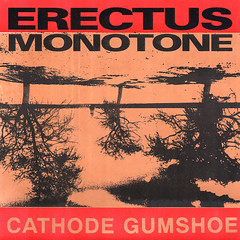

After a pause in recording Eno went back to the studio in 1990, this time with the great John Cale to see if they could come up with something as good as Cale's Eno produced 1974 album, Fear. Instead what happened was that they fell out spectacularly and ended the process absolutely hating each other's guts. What's particularly odd about this is that the album itself, Wrong Way Up (1990), is a really spritely, jaunty collection of pop songs. For once Eno's production ideas went a bit wrong though and the whole album sounds too glossy and for a lot of its running length, rather badly dated. This is a shame because the songs themselves for the most part are the results of the combined strengths of two great songwriters and are really good, really likeable tunes. Cale's instinctive knack for an off-kilter pop melody and Eno's skill at making everything sound warm and engaging are both at work on Wrong Way Up. Finally we skip over Eno's work of the next eighteen years and have 2008's second collaboration with David Byrne, Everything That Happens Will Happen Today. In some ways it's an album cursed by its creation, because at no point in the future will anybody say that it's an album that changed music in the way that My Life in the Bush of Ghosts did. Nonetheless, if you put that remarkable work to one side and judge Everything That Happens Will Happen Today by its own merits, it's a really great record. Byrne's rather forlorn lyrics and melodies are superb and Eno's production creates a really lively and brisk pop sheen, in the best possible sense, over the whole thing. It's a mature record certainly, but it's far from dull and although both men's days of breaking new ground are realistically long over, they're still more than capable of making effective and affecting records that are still better than pretty much anything anybody else is doing.


Before Destiny's Child plagued us with their terrible records, a much better precedent had been set by the ridiculous En Vogue. Funky Divas (1992) is a truly appalling record of cheesy funk, soul and R&B, the songs are dodgy at best, the performances pretty weak. But, and this is a big but, there's something that seems in comparison with the hideous versions of this that get released these days, rather honest and likeable about Funky Divas. It's feels far less aggressively cynical, you can almost believe that both the band and the producers wanted to make something real, a record that people genuinely had a reason to like. It's rubbish, obviously, but I can't help but feel nostalgic for a time when records that wanted your money tried to win you over rather than just rifle through your pockets.

Next up is an early Merge records single by Erectus Monotone called Cathode Gumshoe (1991). I can only find a couple of tunes from it on the internet but they're really good tiny little bits of punky super lo-fi pop.

Finally there's some more lo-fi indie rocking from Canada's Eric's Trip and their third and final album, Purple Blue (1995). Eric's Trip didn't allow borrow their name from Sonic Youth, they used pretty much every other guitar based fuzzy indie rock act to borrow and steal stuff from, and although there's virtually nothing on Purple Blue that hasn't been done before by someone else, it's still a good album, with some great scuzzy indie rock shapes on it. The fact that Rick White and Julie Doiron had different influences helps to ensure that there's a variety of stylistic ripping off going on throughout and on the whole listening to Purple Blue is like taking a highly enjoyable one album road trip through the entire indie scene.

No comments:
Post a Comment